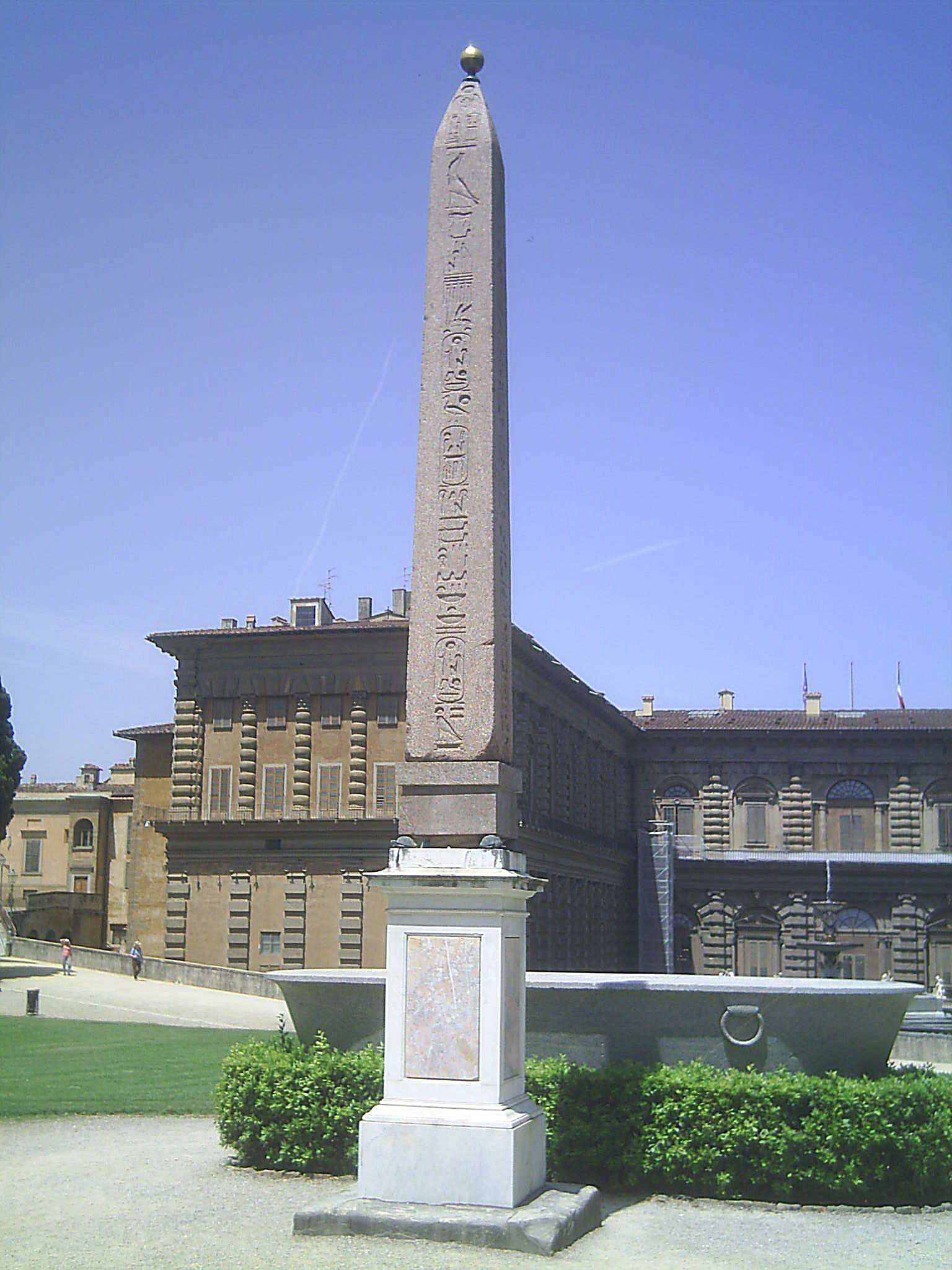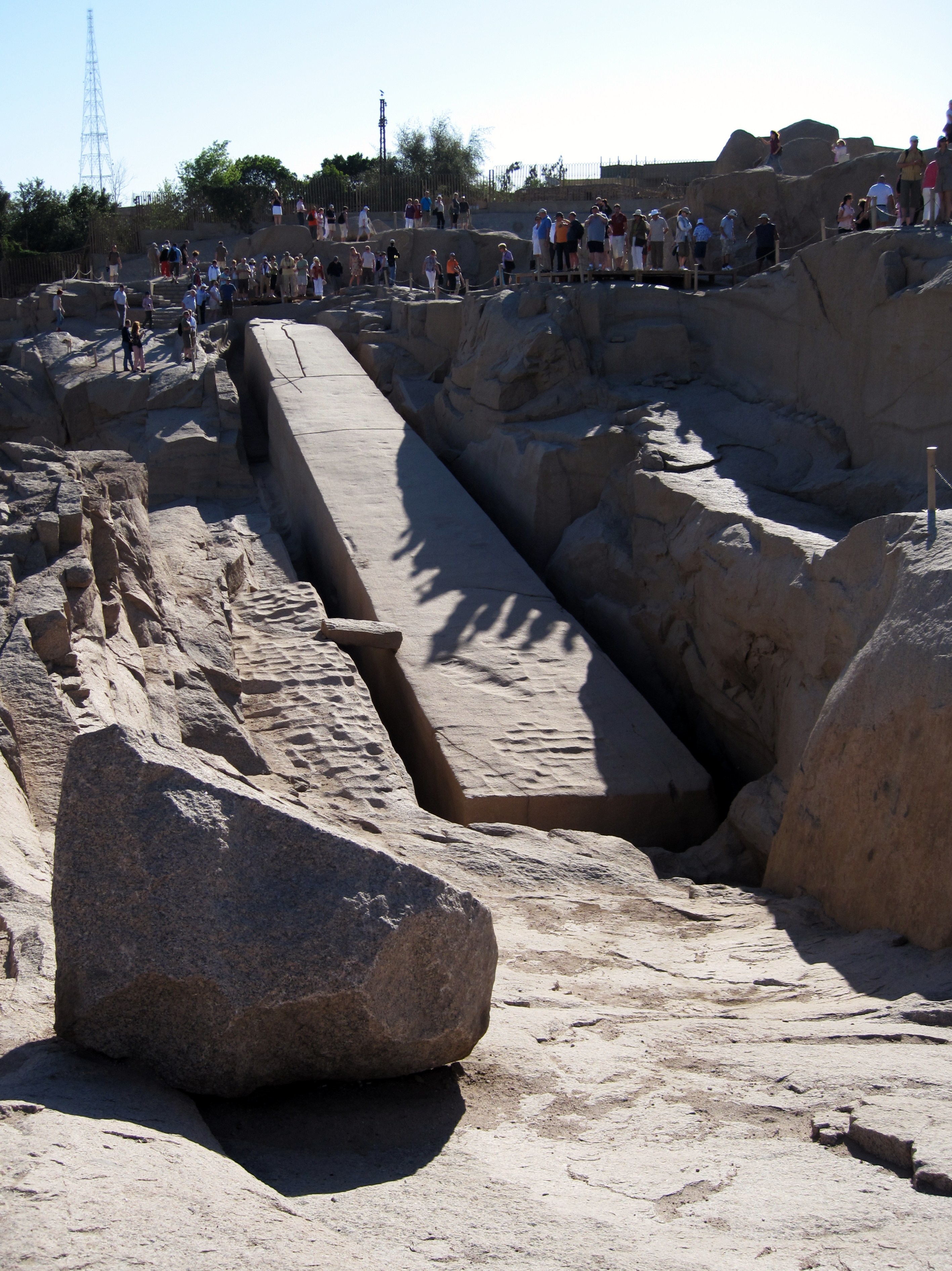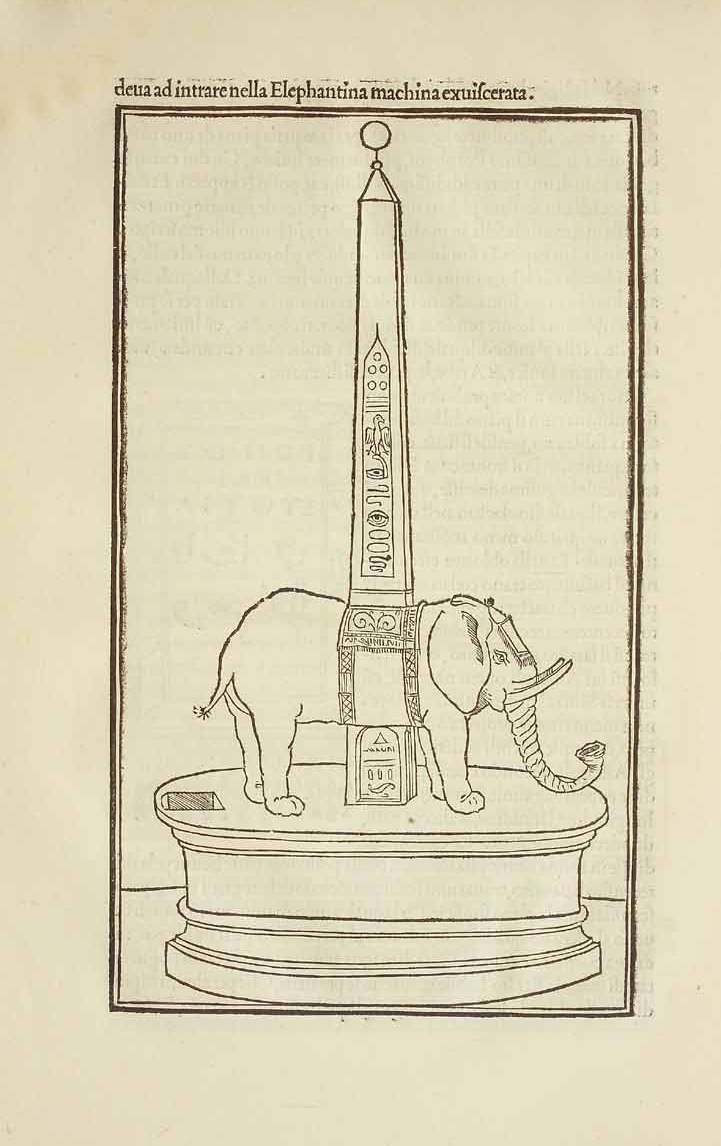|
Boboli Obelisk
The Boboli obelisk, previously called the Obelisco Mediceo, is an ancient Egyptian granite obelisk, which was moved in the 18th century from Rome to Florence, where it was erected in the Boboli Gardens. History The granite from which the obelisk is carved comes from Aswan and the inscriptions are dedicated to Atum, the deity of the city of Heliopolis. It is suspected to have been first erected in that city during the reign of Ramesses II. In the first century AD, it was moved to Rome by Domitian and placed in the Temple of Isis in the Campus Martius, along with three other obelisks still in Rome: the Obelisk at the Monument to those fallen at Dogali, the Obelisk of Piazza of the Pantheon, and the obelisk in front of Santa Minerva. In the sixteenth century, Cardinal Ferdinand I de' Medici bought the 6-metre high obelisk in Rome and placed it in the gardens of the Villa Medici. When the Grand Duke Peter Leopold of Lorraine became Grand-Duke of Tuscany, he transferred to ... [...More Info...] [...Related Items...] OR: [Wikipedia] [Google] [Baidu] |
Obelisk At The Monument To Those Fallen At Dogali
An obelisk (; from grc, ὀβελίσκος ; diminutive of ''obelos'', " spit, nail, pointed pillar") is a tall, four-sided, narrow tapering monument which ends in a pyramid-like shape or pyramidion at the top. Originally constructed by Ancient Egyptians and called ''tekhenu'', the Greeks used the Greek term to describe them, and this word passed into Latin and ultimately English. Ancient obelisks are monolithic; they consist of a single stone. Most modern obelisks are made of several stones. Ancient obelisks Egyptian Obelisks were prominent in the architecture of the ancient Egyptians, and played a vital role in their religion placing them in pairs at the entrance of the temples. The word "obelisk" as used in English today is of Greek rather than Egyptian origin because Herodotus, the Greek traveler, was one of the first classical writers to describe the objects. A number of ancient Egyptian obelisks are known to have survived, plus the " Unfinished Obelisk" found part ... [...More Info...] [...Related Items...] OR: [Wikipedia] [Google] [Baidu] |
List Of Egyptian Obelisks
Obelisks had a prominent role in the architecture and religion of ancient Egypt. This list contains all known remaining ancient Egyptian obelisks. The list does not include modern or pre-modern pseudo-Egyptian obelisks, such as the numerous Egyptian-style obelisks commissioned by Roman Emperors. The list also excludes approximately 40 known obelisk fragments, catalogued by Hiroyuki Nagase and Shoji Okamoto. Number Only about 30 such obelisks are still in existence worldwide; figures vary between sources with different definitions of extant Egyptian obelisks. For example, David Allen states there are 29 such obelisks, with more in Italy than in Egypt. Only two known obelisks date prior to the New Kingdom, both of which were dedicated to the Middle Kingdom Pharaoh Senusret I. At least 22 of the known obelisks date to the New Kingdom, four date to the Late Period and one to the Ptolemaic period. The international transportation of Egyptian obelisks dates to the Roman conquest ... [...More Info...] [...Related Items...] OR: [Wikipedia] [Google] [Baidu] |
Pasquale Poccianti
The Cisternoni of Livorno are a series of three large buildings in the neoclassical style at Livorno, in Tuscany, Italy. They were constructed between 1829 and 1848 as part of a complex of purification plants and storage tanks to the Leopoldino aqueduct; a fourth ''cisternone'' planned at Castellaccia was never built. The '' cisternoni'', literally "great cisterns", provided Livorno — a city that is still today one of the principal ports of the Mediterranean — with fresh and, more importantly, clean water throughout the 19th and 20th centuries. Designed by the architect Pasquale Poccianti, the ''cisternoni'' are architecturally important, as they represent the advent of an aesthetically considered approach to the design of utilitarian public work. This movement, whose followers are sometimes known as "Utopians", was pioneered by such architects as Étienne-Louis Boullée and Claude-Nicolas Ledoux at the close of the 18th century. The movement resulted in great ... [...More Info...] [...Related Items...] OR: [Wikipedia] [Google] [Baidu] |
Terme Alessandrine
Terme (formerly spelled ''Termeh''; Ancient Greek: Thèrmae, Θέρμαι) is the seat of Terme District, Samsun Province, Turkey. Terme is located on Terme River, about 5 km from its mouth, on the eastern end of the Çarşamba Plain. Terme or its environs are the site of the ancient city of Themiscyra, Θεμίσκυρα. Terme District is the site of an annual festival celebrating the Amazons, an ancient nation of all-female warriors who, according to Greek myth, were believed to have lived in the Samsun region. See also * Themiscyra Plain Themiscyra may refer to: * Themiscyra (Pontus), an ancient Greek town, the home of the legendary Amazons * Themyscira (DC Comics) Themyscira () is a fictional unitary state, unitary sovereign state, sovereign city-state and Archipelagic state, ... References Populated places in Samsun Province Fishing communities in Turkey Districts of Samsun Province {{Samsun-geo-stub ... [...More Info...] [...Related Items...] OR: [Wikipedia] [Google] [Baidu] |
Grand Duke Peter Leopold Of Lorraine
, house =Habsburg-Lorraine , father = Francis I, Holy Roman Emperor , mother = Maria Theresa of Hungary and Bohemia , religion =Roman Catholicism , succession1 =Grand Duke of Tuscany , reign1 =18 August 1765 – 22 July 1790 , predecessor1 = Francis Stephen , successor1 = Ferdinand III , date of burial = , place of burial = Imperial Crypt , signature =Signatur Leopold II. (HRR).PNG Leopold II (Peter Leopold Josef Anton Joachim Pius Gotthard; 5 May 1747 – 1 March 1792) was Holy Roman Emperor, King of Hungary and Bohemia, and Archduke of Austria from 1790 to 1792, and Grand Duke of Tuscany from 1765 to 1790. He was a son of Empress Maria Theresa and her husband, Emperor Francis I, and the brother of Marie Antoinette, Queen of France, Maria Carolina, Queen of Naples, Maria Amalia, Duchess of Parma, and Joseph II, Holy Roman Emperor. Leopold was a moderate proponent of enlightened absolutism. He granted the Aca ... [...More Info...] [...Related Items...] OR: [Wikipedia] [Google] [Baidu] |
Villa Medici
The Villa Medici () is a Mannerist villa and an architectural complex with a garden contiguous with the larger Borghese gardens, on the Pincian Hill next to Trinità dei Monti in Rome, Italy. The Villa Medici, founded by Ferdinando I de' Medici, Grand Duke of Tuscany and now property of the French State, has housed the French Academy in Rome since 1803. A musical evocation of its garden fountains features in Ottorino Respighi's ''Fountains of Rome''. History In ancient times, the site of the Villa Medici was part of the gardens of Lucullus, which passed into the hands of the Imperial family with Messalina, who was murdered in the villa. In 1564, when the nephews of Cardinal Giovanni Ricci of Montepulciano acquired the property, it had long been abandoned to viticulture. The sole dwelling was the Casina of ''Cardinale'' Marcello Crescenzi, who had maintained a vineyard here and had begun improvements to the villa under the direction of the Florentine Nanni Lippi, who had died ... [...More Info...] [...Related Items...] OR: [Wikipedia] [Google] [Baidu] |
Ferdinand I De' Medici
Ferdinando I de' Medici, Grand Duke of Tuscany (30 July 1549 – 3 February 1609) was Grand Duke of Tuscany from 1587 to 1609, having succeeded his older brother Francesco I. Early life Ferdinando was the fifth son (the third surviving at the time of his birth) of Cosimo I de' Medici, Grand Duke of Tuscany, and Eleanor of Toledo, the daughter of Pedro Álvarez de Toledo, Marquis of Villafranca, the Spanish viceroy of the Kingdom of Naples. He was made a Cardinal in 1562 at the age of 14, but was never ordained into the priesthood. At Rome, he proved an able administrator. He founded the Villa Medici in Rome and acquired many works of art (including the ''Medici lions''), which he then brought back to Florence with him. Grand Duke When his brother Francesco I de' Medici, Grand Duke of Tuscany, died in 1587, Ferdinando succeeded as grand duke at the age of 38. In many ways, Ferdinando was the opposite of his brother who preceded him. Approachable and generous, he set out ... [...More Info...] [...Related Items...] OR: [Wikipedia] [Google] [Baidu] |
Elephant And Obelisk
''Elephant and Obelisk'' is a statue of an elephant carrying an obelisk, designed by the Italian artist Gian Lorenzo Bernini. It was unveiled in 1667 in the Piazza della Minerva in Rome, adjacent to the church of Santa Maria sopra Minerva, where it stands today. The obelisk The red granite obelisk was discovered in 1665 during excavations near the church of Santa Maria sopra Minerva. It had probably been brought to Rome in the first century AD for the temple to the Egyptian goddess Isis that was located there. The obelisk was originally erected by Pharaoh Apries of the Twenty-sixth Dynasty of Egypt, about 580 BC, in his capital Sais. The obelisk is 5.47 meters tall and is the smallest of the 13 ancient obelisks present in Rome nowadays. Together with pedestal and elephant, the statue stands 12.69 meters tall. The obelisk is considered to be one of a pair, the other is in Urbino. The elephant statue The image possibly originated from the '' Hypnerotomachia Polyphili'' of 14 ... [...More Info...] [...Related Items...] OR: [Wikipedia] [Google] [Baidu] |
Obelisk Of Piazza Of The Pantheon
An obelisk (; from grc, ὀβελίσκος ; diminutive of ''obelos'', " spit, nail, pointed pillar") is a tall, four-sided, narrow tapering monument which ends in a pyramid-like shape or pyramidion at the top. Originally constructed by Ancient Egyptians and called ''tekhenu'', the Greeks used the Greek term to describe them, and this word passed into Latin and ultimately English. Ancient obelisks are monolithic; they consist of a single stone. Most modern obelisks are made of several stones. Ancient obelisks Egyptian Obelisks were prominent in the architecture of the ancient Egyptians, and played a vital role in their religion placing them in pairs at the entrance of the temples. The word "obelisk" as used in English today is of Greek rather than Egyptian origin because Herodotus, the Greek traveler, was one of the first classical writers to describe the objects. A number of ancient Egyptian obelisks are known to have survived, plus the " Unfinished Obelisk" found part ... [...More Info...] [...Related Items...] OR: [Wikipedia] [Google] [Baidu] |
Campus Martius
The Campus Martius (Latin for the "Field of Mars", Italian ''Campo Marzio'') was a publicly owned area of ancient Rome about in extent. In the Middle Ages, it was the most populous area of Rome. The IV rione of Rome, Campo Marzio, which covers a smaller section of the original area, bears the same name. Antiquity According to Rome's foundation myth, prior to the founding of the city, Rhea Silvia had her twin sons, Romulus and Remus, taken by the King of Alba Longa. The boys were later discarded in the swelling Tiber River, which would later run along the Campus' western boundary. Washing ashore further downriver, the brothers would return decades later to found a new city. Romulus, who became Rome's sole king (after killing his brother Remus), ruled for many years until sometime in the seventh century B.C. As he came to the end of his life, a storm cloud descended upon the center of the open field outside the city's pomerium in order to lift the elderly king to heaven.Jacobs ... [...More Info...] [...Related Items...] OR: [Wikipedia] [Google] [Baidu] |







